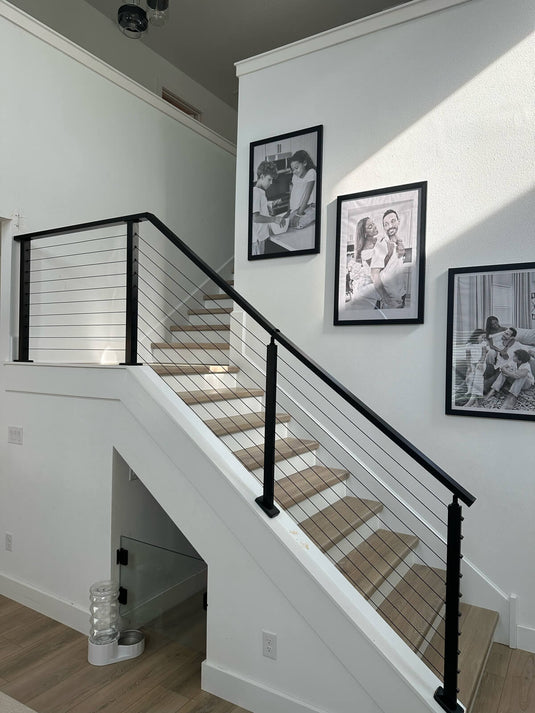TABLE OF CONTENTS
Stylish Cable Deck Railing with Wood Posts: A Modern Touch
Deck design has never been more innovative and inviting than the fusion of sleek, durable cable deck railing paired with the classic touch of wood posts. This modern combination not only offers an uncluttered view and a contemporary aesthetic but also brings the warm, natural charm of wood to your outdoor spaces. In this guide, we'll talk about the practicalities and design considerations of integrating cable deck railing with wood posts, ensuring your deck not only stands out but stands firm against the test of time. Whether you're a DIY enthusiast or planning to hire a professional, we’ll provide you with detailed, easy-to-understand insights that will transform your deck into a stylish, welcoming extension of your home.

Cable Deck Railing
Designing a deck that is both visually striking and structurally sound, cable deck railing offers a solution that's hard to beat. But what exactly is this type of railing, and why might it be the perfect choice for your outdoor living space?
The Basics of Cable Deck Railing
A cable deck railing is a type of barrier used on decks or patios. Thin, stainless steel cables are strung horizontally between vertical posts made of various materials, including wood, metal, or composite. This design offers a modern, industrial-inspired look that has gained popularity for its minimalist appearance and the way it preserves views while providing safety.
Materials Used in Cable Deck Railing Systems
The star materials in a cable railing system are the cables themselves, typically made from high-strength, weather-resistant stainless steel that offers longevity and ease of maintenance. The posts, which provide the framework, can be crafted from several types of materials, but we will focus on wood for its natural aesthetics and versatility.
Advantages Over Traditional Railings
Cable railings provide several advantages over their traditional counterparts:
● Durability and Longevity: Stainless steel cables resist corrosion and wear from harsh weather conditions, making them particularly suitable for outdoor use.● Unobstructed Views: Due to their slender profile, cable railings create a safety barrier without obstructing the scenic views that decks often provide.
● Minimal Maintenance: Unlike some other railing types that require frequent painting or staining, cable railings need only occasional cleaning and tension adjustment.
Design Considerations
Before you decide on the cable deck railing, there are a few design considerations to keep in mind:
● Tension Requirements: Cable railings must be properly tensioned to prevent sagging and to comply with building codes. This means they often require sturdy end posts capable of withstanding the force applied by the tensioned cables.● Spacing Guidelines: To ensure safety and meet building codes, there are specific guidelines regarding the spacing of the cables and the size of the gaps between them.
● Visual Impact: While cable railings are less visible than other types, the hardware and end fittings can have a significant visual impact on the final design. Choose components that complement your home’s style.
Why Wood Posts?
Wooden posts are a hallmark of traditional deck design, but when paired with cable railings, they adopt an entirely new level of sophistication and modernity.

Natural Beauty and Warmth
Wood offers a timeless quality that exudes warmth and comfort, attributes that metal or composite materials often can't match. Each wood species has its unique grain pattern, color, and texture, contributing to a natural aesthetic that can make your outdoor space feel more inviting. The presence of wood in any structure brings a bit of nature closer to home, creating a serene and cozy atmosphere ideal for relaxation or entertaining guests.
Versatility in Design
Whether you're aiming for a rustic charm or a chic, contemporary vibe, wood can be adapted to suit any style. It can be stained, painted, or treated with various finishes to enhance its natural qualities or align with your design vision. Different species of wood will also offer their own particular strengths and visual appeal, from the rich tones of mahogany to the classic look of pine or the durability of cedar.
Contrasting Textures
The combination of cable deck railing with wooden posts creates a delightful contrast in textures — the smooth, reflective quality of the steel juxtaposed against the rugged, organic feel of the wood. This interplay of materials can add depth and character to your deck, making it not just a functional space but a work of art.
Color Blending and Harmony
Choosing the right wood tone can complement or contrast with the metallic sheen of the cables, depending on the desired effect. Lighter woods can create a subtle, airy feel, while darker tones can ground the design and draw attention to the view beyond. By carefully selecting the type and finish of the wood, you can achieve a harmonious blend of colors that elevates the overall look of your deck.
The natural characteristics of wood bring a balance to the sleekness of cable railings, offering both visual interest and a tactile quality that metal alone cannot provide.
Practical Installation Tips for Cable Deck Railing
Installing your cable deck railing with wood posts can be a rewarding DIY project or something you might want an experienced professional to handle. Either way, understanding the installation process can help ensure a smooth execution.
Tools and Materials Checklist
Before the installation, it's essential to have all the necessary tools and materials on hand. Here’s what you’ll typically need:
● Tape measure● Drill with various bits
● Cable cutters
● Kit
● Cable crimping tool
● Level
● Wrenches
● Stainless steel cables and fittings
● Wood posts (cut to specifications)
● Protective gear (gloves, safety glasses)
Ensure you have extra materials in case of mistakes or adjustments. Also, invest in high-quality tools and components to enhance the longevity and appearance of your railing.
Step-by-Step Installation Guide
Follow these general steps to install your cable deck railing with wood posts:
1. Post Installation: Securely install the wood posts at the proper intervals along the perimeter of your deck. They should be anchored deeply enough to withstand the tension of the cables. Also, Attach the handrail directly to the top of the newly installed posts to prevent any bending of the posts under the tension of the cables later.
2. Drilling Holes: Carefully measure and drill holes in your posts for the cables to pass through. The holes must be level and evenly spaced to maintain a uniform look and comply with safety codes.
3. Threading Cables: Thread the cables through the holes in each post, starting from one end post and continuing to the opposite end.
4. Securing Cables: Affix the end fittings to the cables, which may involve swaging (crimping) techniques for a secure hold. Pay close attention to the manufacturer's instructions for fitting assembly.
5. Tensioning Cables: Once all cables are in place, use a tensioning tool to pull them taut. The tension should be firm to prevent sagging but not so tight that it puts undue stress on the posts.
6. Final Adjustments: Walk around the entire deck to check each cable's tension and alignment. Make any necessary adjustments to ensure consistency and safety throughout the railing system.

Troubleshooting Common Installation Challenges
● Cable Tensioning: If a cable isn't properly tensioned, it can lead to sagging or even become a safety hazard. Regular checks and adjustments may be needed over time as cables can stretch slightly with initial use.● Preventing Wood Splitting or Damage: When drilling into wood, go slowly to avoid splitting. Using a bit that is the appropriate size for your cable and fittings will also help preserve the integrity of the wood.
Finishing Touches
After installing the cables and ensuring everything is adequately tensioned and secure, inspect your work for any sharp edges or protruding hardware that could snag clothing or scratch skin. Add end caps where necessary, and consider sanding down the wood posts one last time before applying a sealant for weather protection.
The installation process demands attention to detail, patience, and adherence to safety standards.
Get a Natural Elegance of Cable Deck Railing with Wood Posts
Integrating stylish cable deck railing with wood posts achieves a harmonious blend of modern sophistication and classic charm, marrying the unobtrusive elegance of stainless steel cables with wood's natural beauty and warmth. This design choice enhances your outdoor living space aesthetically and ensures durability and longevity with minimal maintenance. Whether undertaken as a DIY project or installed by professionals, the practicalities of this system—from careful tensioning to precise drilling—demand a meticulous approach that pays off in the form of a stunning, secure deck area that invites relaxation and admiration. With the right tools, materials, and attention to detail, your deck can become an extension of your home and a standout feature that encapsulates contemporary design and traditional allure.




